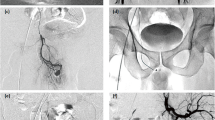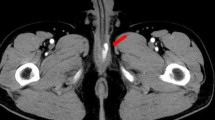Abstract
High flow priapism is mainly caused by traumatic arteriocavernous fistulas. The standard therapy is a transcatheter embolization of the fistula. This study analyzes the combined approach of arteriography and color Doppler ultrasound during the embolization procedure. During the arteriography procedure, a perineal color Doppler ultrasound examination of the fistula was performed to achieve an optimal positioning of the catheter tip in the fistula with a minimum of radiation exposure. To visualize the correct localization, ultrasound contrast medium or saline solution was injected through the catheter. The flow-pattern of the contrast medium allowed evaluation of the successful occlusion of the fistula and preservation of the unaffected penile arteries. In six patients (unilateral fistula: three, bilateral fistulas: three) with a posttraumatic high-flow priapism, this technique was performed for embolization of the fistulas. A total of nine embolization sessions were performed. Only one case required a second session due to dislocation of a microcoil. In all cases, the priapism disappeared immediately after the final session while erectile function was restored within 4 weeks after embolization. The combined approach of x-ray and ultrasound imaging facilitates the supraselective embolization of the arteriocavernous fistula, leading to an optimal success rate, while reducing the radiation exposure and the applied dose of contrast medium.
Similar content being viewed by others
References
Burt FB, Schirmer HK, Scott WW (1960) A new concept in the management of priapism. J Urol 83:60–63
Goerich J, Ermis C, Kraemer SC et al. (2002) Interventional treatment of traumatic priapism. J Endovasc Ther 9:614–617
Hakim LS, Kulaksizoglu H, Mulligan R et al. (1996) Evolving concepts in the diagnosis and treatment of arterial high flow priapism. J Urol 155:541–548
Hauri D, Spycher M, Bruehlmann W (1983) Erection and priapism: a new physiopathological concept. Urol Int 38:138–145
Kuefer R, Bartsch GJr, Herkommer K et al. (2004) Changing diagnostic and therapeutic concepts in high-flow priapism. Int J Impot Res (in press)
Miller ST, Rao SP, Dunn EK et al. (1995) Priapism in children with sickle cell disease. J Urol 154:844–847
Sancak T, Conkbayir I (2001) Post-traumatic high-flow priapism: management by superselective transcatheter autologous clot embolization and duplex sonography-guided compression. J Clin Ultrasound 29:349–353
Volkmer BG, Nesslauer T, Kuefer R et al. (2002) High-flow priapism: a combined interventional approach with angiography and colour Doppler. Ultrasound Med Biol 28:165–169
Volkmer BG, Nesslauer T, Kraemer SC et al. (2001) Prepubertal high-flow priapism: incidence, diagnosis and treatment. J Urol 166:1018–1022
Wear JBJr, Crummy AB, Munson BO (1977) A new approach to the treatment of priapism. J Urol 117:252–254
Author information
Authors and Affiliations
Corresponding author
Rights and permissions
About this article
Cite this article
Bartsch, G., Kuefer, R., Engel, O. et al. High-flow priapism: colour-Doppler ultrasound-guided supraselective embolization therapy. World J Urol 22, 368–370 (2004). https://doi.org/10.1007/s00345-004-0426-8
Received:
Accepted:
Published:
Issue Date:
DOI: https://doi.org/10.1007/s00345-004-0426-8




